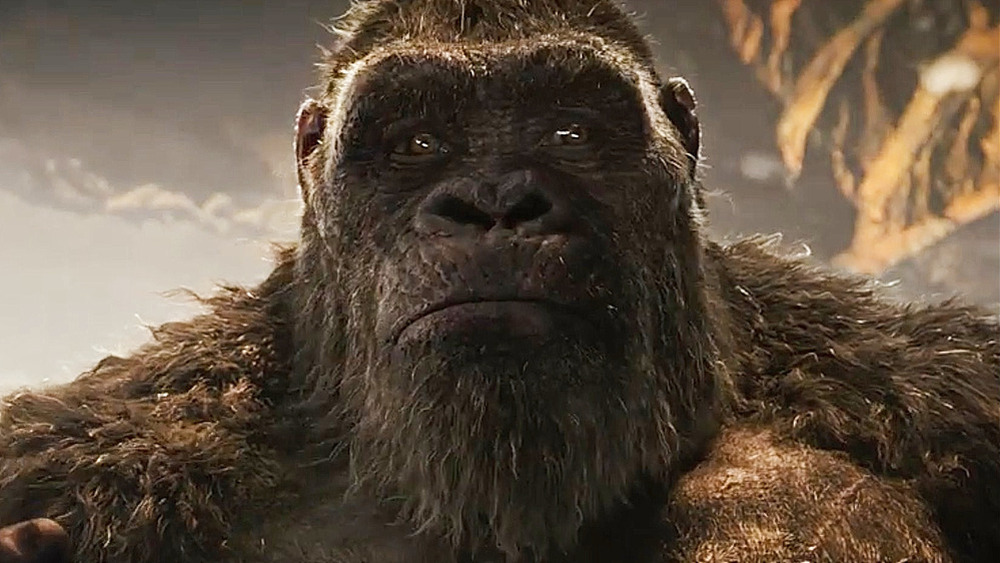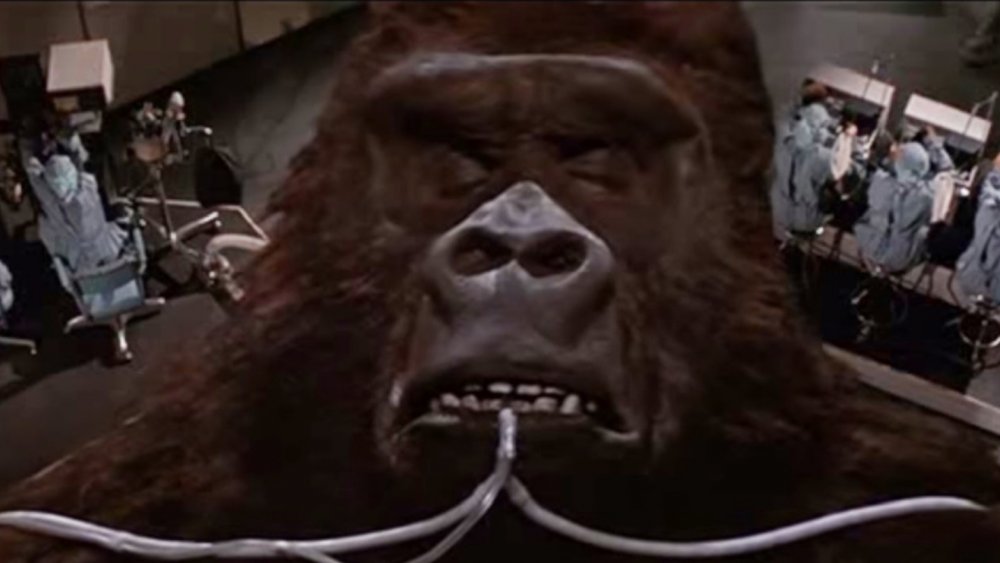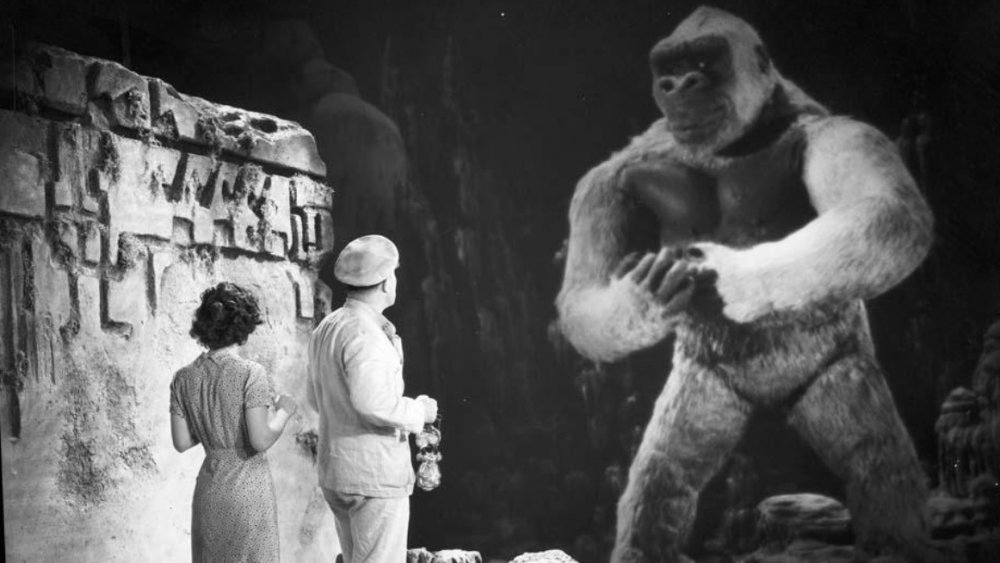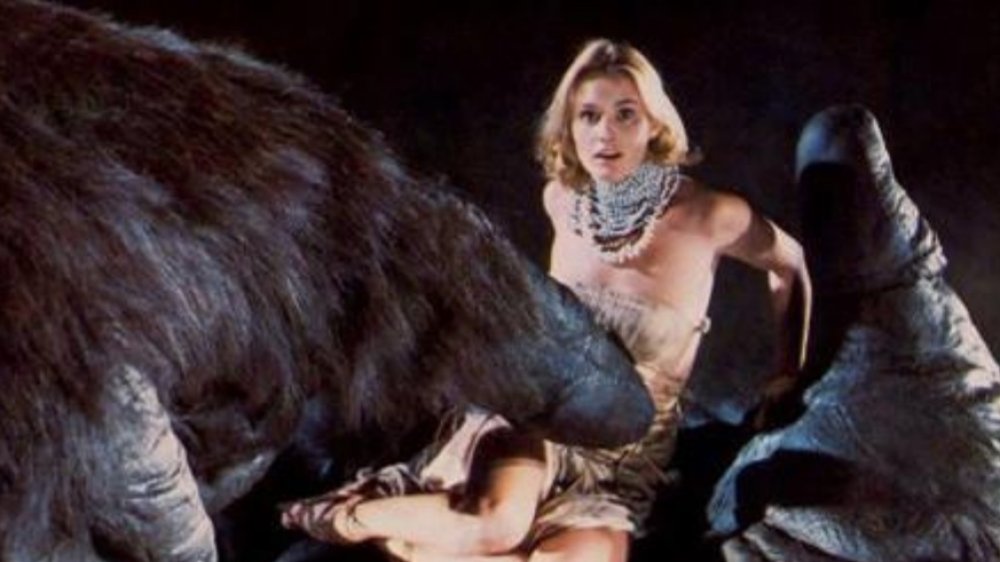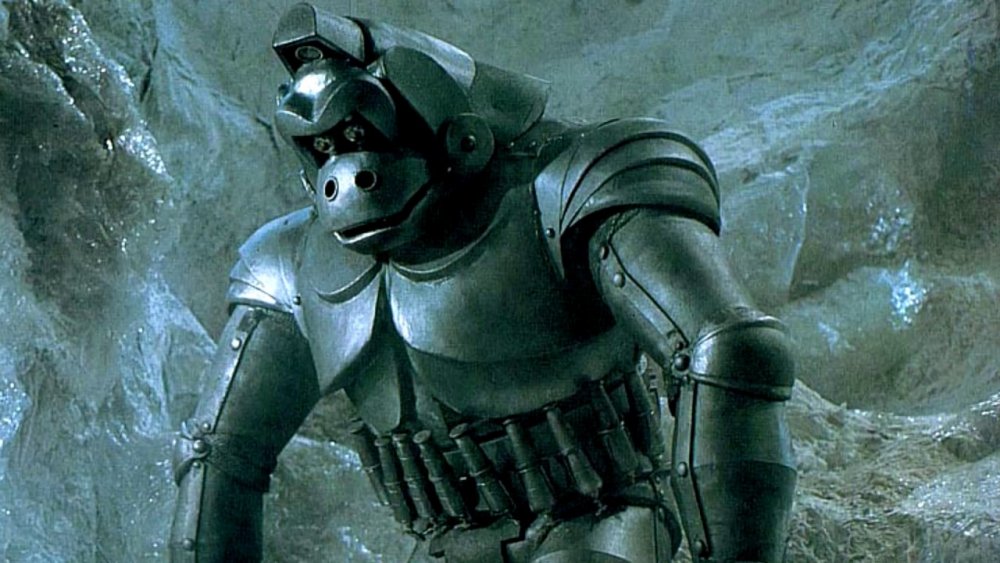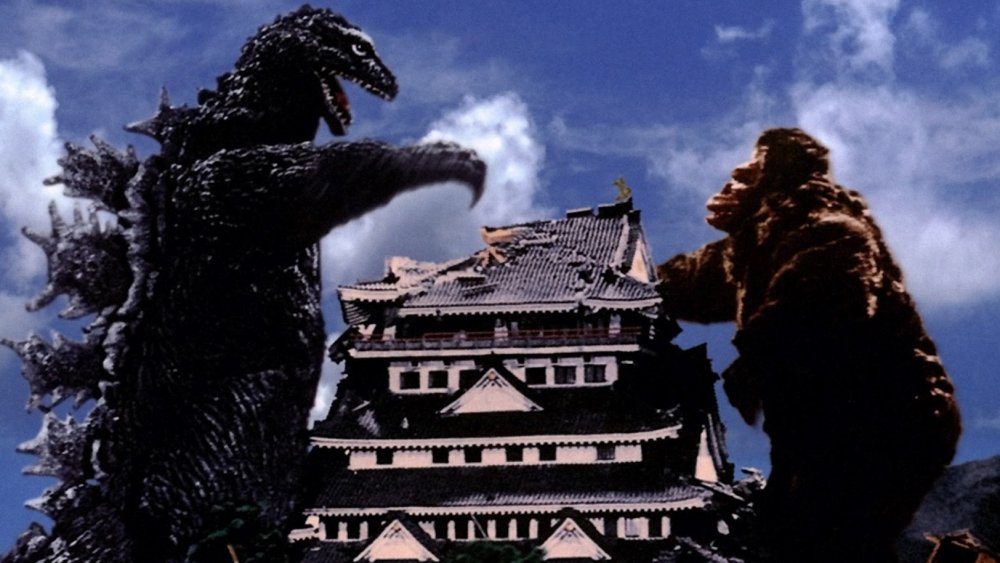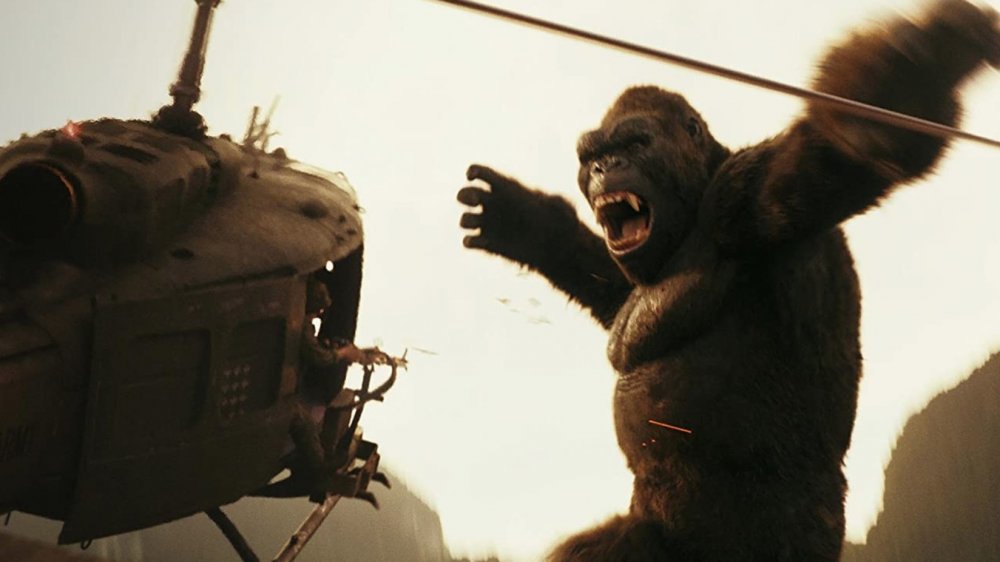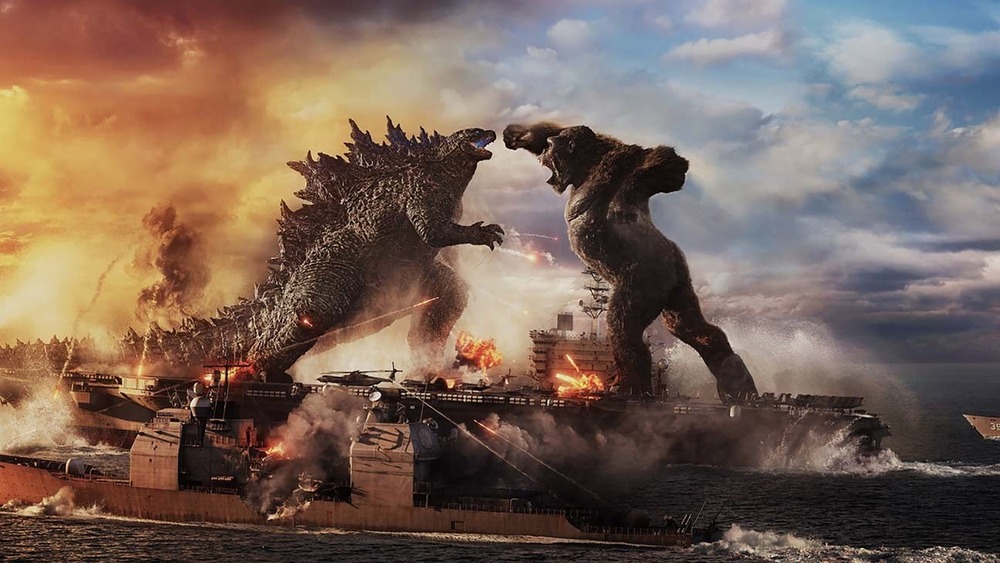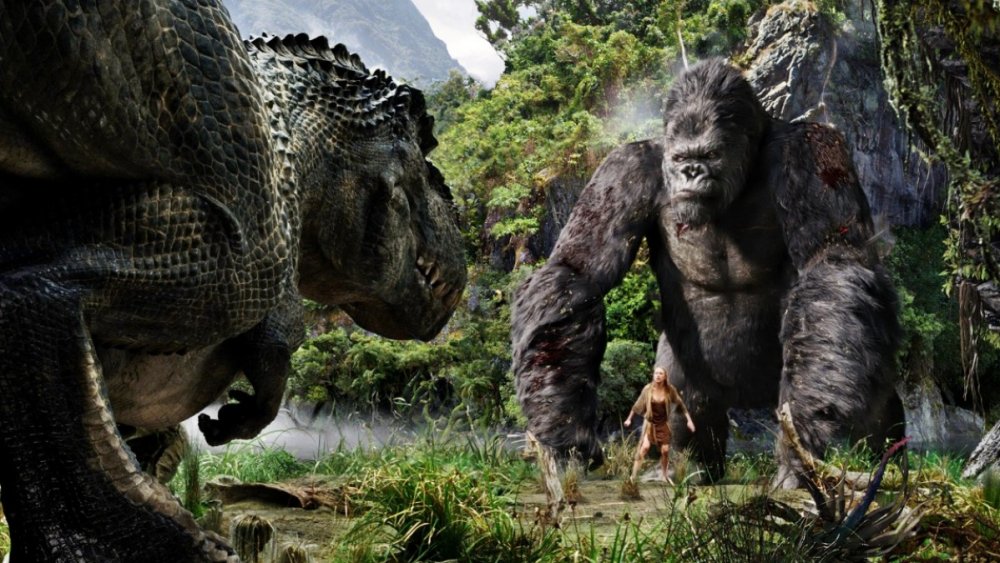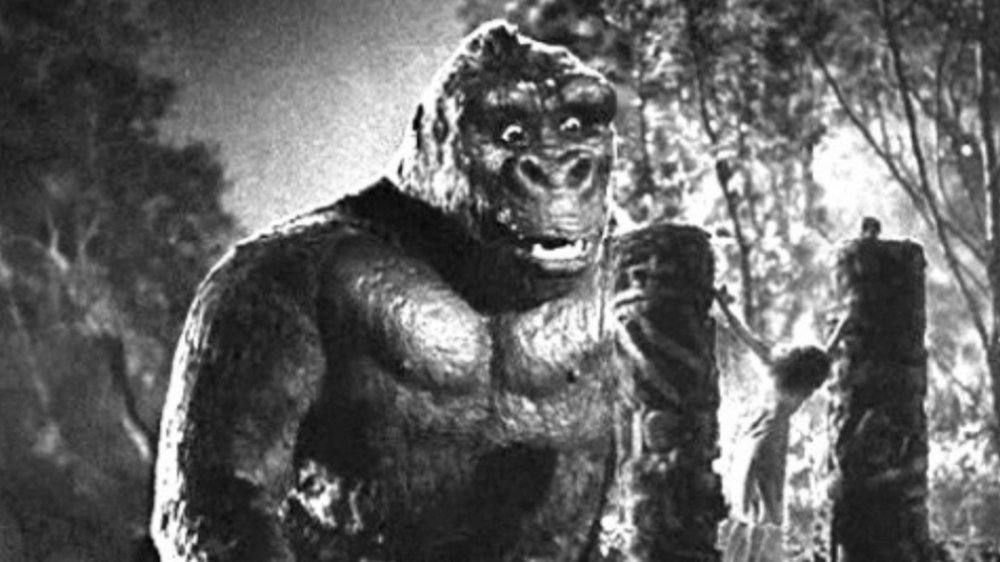Every King Kong Movie Ranked Worst To Best
The most memorable movie character to emerge from the Golden Age of Hollywood wasn't a conniving Southern belle, a cynical Casablanca bar owner, or even a singing Kansas girl and her little dog, too. It was a gargantuan gorilla with an attraction for blondes. You may not have seen the seven wonders of the world, but you've certainly seen the eighth: King Kong.
Only Old Hollywood could produce a character so outlandish and yet make him so loveable at the same time. King Kong is fantasy with a capital "F", but the character continues to stand the test of time because he's all too human. Strange as it is to say, we can relate to the big ape. We cheer for him as he goes mano-a-mano (well, primate-a-dinosaur) with a Tyrannosaurus rex trying to chomp down on Fay Wray, and we tear up as he plunges to his demise off the top of the Empire State Building.
Beauty may have killed the beast, but King Kong's star power has never diminished after nearly a century, and it shows no signs of slowing down. It's rare for a human character to be this beloved for so long but a monster? That's reserved for only a select few. But while all of King Kong's cinematic outings have been memorable, there are some we'd like to forget. Which King Kong movies are classics, and which should have never left the island? Here's every King Kong movie ranked worst to best!
King Kong Lives nearly killed the series
With a 0 percent Tomatometer score, King Kong Lives is the worst King Kong movie, and it's also in the running for "Worst Movie Ever." Released ten years after Dino De Laurentiis' King Kong in 1976, King Kong Lives is the sequel nobody wanted to the remake nobody asked for, with none of the stars from the first film and a fraction of the budget. Turns out King Kong survived his nearly 2,000-foot fall from atop the World Trade Center (in one of the first instances of retconning), but he needs an artificial heart to survive. Yes, there's even a surgery scene. If that isn't bizarre enough, the film also features Kong courting a female Kong.
Like, we get that De Laurentiis wanted to make a sequel, albeit ten years after anyone cared, but this was the best they could do? King Kong Lives came out 53 years after the original King Kong, and yet its special effects are less convincing. While King Kong's stop-motion animation was groundbreaking, King Kong Lives (and its 1976 predecessor) opted for the more primitive filmmaking technique of putting a man in a gorilla suit. It's little wonder King Kong Lives was a Raspberry Award nominee for "Worst Special Effects," as we're pretty sure we could make a more convincing giant gorilla movie with a Halloween costume and a cell phone. King Kong Lives bombed with $4.7 million worldwide, killing off the character for 20 years.
Son of Kong was the rushed sequel nobody wanted
King Kong Lives came out ten years after 1976's King Kong, an eternity between sequels, but Hollywood didn't always move so slowly. Nowadays, the sweet spot is about a two to three year gap between films. Any shorter and you risk overcrowding the marketplace. Any longer and your audience may move on. Well, in Old Hollywood there was no such concern, as the only philosophy was "strike while the iron is hot!"
So while King Kong was released in New York City on March 2, 1933, its sequel Son of Kong came out on December 22, 1933. Yep, RKO Pictures wrote, produced, edited, and released a sequel in nine months! You're lucky to have a first draft of your screenplay done in nine months these days. Gotta' admire that efficiency. But while you can respect their work ethic, you can't respect the finished product.
Son of Kong is just over 69 minutes long, so it barely even qualifies as a feature film, and it's so thrown together that it barely qualifies as a movie-going experience. As for the plot, Carl Denham — the explorer/filmmaker from the original movie — has been sued into bankruptcy and returns to Skull Island in the hopes of finding treasure to pay off his debts, but instead, he finds a 25-foot-tall, albino, baby Kong instead. Son of Kong followed its predecessor's breakthrough success with a totally unnecessary sequel that killed whatever chance Kong had of being a multi-film series, a la the Universal Studios monster films.
King Kong (1976) was a monster disappointment
It was only natural a King Kong remake would arrive in the 1970s, the same era as The Towering Inferno, The Poseidon Adventure, and Jaws. Naturally, the man to bring it to the screen was Dino De Laurentiis. De Laurentiis didn't know the meaning of the word "small" and assembled a $24 million budget, about $108 million today, to top Spielberg's killer fish. The production spent $1.7 million alone on a 40-foot-tall Kong animatronic made with 3.5-tons of aluminum and 1,012 pounds of Argentinian horsetails, but it was barely even used in the film. The eight-month shoot featured 12-hour days, which tested the resolve of its stars Jeff Bridges and Charles Grodin, as well as Jessica Lange in her first major part (a role Meryl Streep auditioned for).
And since this was the 1970s, they couldn't just make a movie — they also had to make a statement. Grodin's evil oil exec travels to Kong's island seeking black gold, but he exploits the famous big gorilla instead. While King Kong mostly relied on the man-in-suit technique that looked less realistic than its 1933 predecessor, the movie still snagged a Special Achievement Oscar for Special Effects (which just goes to show how groundbreaking Star Wars was in 1977). King Kong earned $52 million, making it the fourth biggest hit of 1976, but it was disappointing considering that was just 20 percent of what Jaws earned the year before. Today, Kong fans rightly view De Laurentiis' King Kong as a monster disappointment.
King Kong Escapes is great escapist entertainment
Following the enormous success of King Kong vs. Godzilla in 1962, RKO allowed Toho Studios to produce a sequel. Toho pitched a script pitting the mighty ape against a giant lobster, Ebirah, which RKO rejected (Toho kept the story but replaced King Kong with Godzilla and named the film Ebirah: Horror of the Deep). RKO now mandated that Toho co-produce the film with American studio Rankin/Bass, which was featuring King Kong in a popular Saturday morning cartoon, The King Kong Show. In fact, there was already a script produced, which was basically a big screen remake of the cartoon, including the TV show's villain, Dr. Who (no, not the British character Doctor Who that premiered in 1963).
The result was King Kong Escapes. Toho pulled out all the stops for this film, assigning its top kaiju director, Ishiro Honda, to the project, alongside A-list actors Akira Takarada and Mie Hama, as well as C-List American actors. However, King Kong Escapes isn't a sequel to the original Kong or even King Kong vs. Godzilla. Instead, it exists in its own universe. The film has a lot of plot, but basically, King Kong rescues an expedition from a dinosaur, is brought back to Tokyo, and must stop a mad scientist from taking over the world by battling his own mechanical double, Mechani-Kong. In other words, it's a cross between an American Saturday morning cartoon and a Japanese kaiju movie. In other words, you should absolutely watch it.
King Kong vs. Godzilla is a kaiju classic
Over 50 years before Batman battled Superman and Captain American fought Iron Man, King Kong went toe-to-toe with Godzila, and it ... was ... awesome! King Kong vs. Godzilla screams no-brainer, but its path to the big screen was anything but straightforward. The stop-motion genius behind the original King Kong, Willis O'Brien, wanted to pit Kong against Frankenstein's monster, but Universal (which owns the iconic bolts-in-neck Frankenstein character) nixed the project. O'Brien's pitch made its way to Toho Studios, but they wanted to replace Frankenstein's monster with their own creation, Godzilla, who'd been on a seven-year hiatus. A new script was written without O'Brien's knowledge, and Merian C. Cooper (Kong's creator) even sued to stop it. Thankfully, he failed.
King Kong vs. Godzilla is a landmark sci-fi film that launched the kitschy, colorful spirit that would define the previously somber Godzilla series. The film was a massive hit in Japan, and so it was rewritten to feature American actors and distributed in the United States, where it performed well, earning $1.25 million profit (or about $20 million today). Contrary to popular lore, there's no alternate Japanese ending where Godzilla's swims off in victory instead of Kong. However, the original Japanese version is much different from the American one, and it's really more of a comedic satire. This version was elusive until Criterion Collection released it in 2019. Whichever version you see, King Kong vs. Godzilla is a classic of the kaiju genre and one of Kong's most famous cinematic appearances.
We loved our trip to Kong: Skull Island
Gareth Edward's Godzilla brought the Big G back to American movie screens in 2014, defying even the highest expectations when it opened to $93 million and earned $524 million worldwide on a $160 million budget. Kaiju flicks suddenly meant cash, and Legendary Pictures hoped to capitalize on moviegoer's sudden appetite for cinematic crossovers that was spawned by the Marvel Cinematic Universe and launched their own series, the MonsterVerse. The next film in the series would bring back arguably the most famous monster in movies — King Kong.
Kong: Skull Island assembled a stacked cast (Tom Hiddleston, Brie Larson, John Goodman, Samuel L. Jackson, John C. Reilly), but the biggest star was Kong. Skull Island wasn't a sequel or remake but a reboot, and it ballooned the monster ape's height to 100 feet and dialed the cinematic spectacle up to 11. It somehow managed to pay homage to Apocalypse Now and still give audiences what they paid to see — big monsters beating the crap out of each other.
Kong: Skull Island received a 75 percent Tomatometer ranking, and earned $168 million domestically and $566 million worldwide on a $185 million budget, making it the most successful movie so far in the MonsterVerse (and the King Kong series, too). Kong: Skull Island is better than it had any right to be, with strong performances, a breakneck pace, compelling characters you love to root for, and enough cinematic monster carnage to create the perfect Saturday matinee.
Godzilla vs. Kong is a historic rematch
Nearly 60 years after King Kong vs. Godzilla, the big lizard got his rematch in 2021's Godzilla vs. Kong. Besides being a much better movie than the original — 79% critical score and 95% audience score on Rotten Tomatoes — Godzilla vs. Kong could be more historically significant, too. That's pretty impressive, considering King Kong vs. Godzilla was groundbreaking, launching the Toho Godzilla series from a black-and-white, somber affair into the brightly colored, lighthearted Godzilla vs. _____ format we know and love (and that Toho milked for years). However, Godzilla vs. Kong received the widest theater count of the pandemic era while also being released on streamer HBO Max, signaling a return to "normalcy." You couldn't find a more unlikely candidate.
Godzilla: King of the Monsters underwhelmed during the infamous summer of 2019, casting the MonsterVerse's future in doubt. Godzilla vs. Kong seemed destined to disappoint ... then the first trailer dropped and became the fourth most liked trailer ever. In some strange way, Godzilla vs. Kong became the movie audiences needed. As critic Shirley Li wrote in The Atlantic, "It's kind of admirable how aggressively Godzilla vs. Kong eschews any grander meaning." In an era when every big, dumb blockbuster thinks adding "darkness" and "meaning" makes it better, Godzilla vs. Kong succeeds because it's just a big, dumb blockbuster — and it does it well! Seriously, if you're looking for epic fights between towering beasts, or if you just really want to see an oversized gorilla wielding an axe, well, Adam Wingard's action flick is definitely the film for you. Godzilla vs. Kong may go down in movie history, but it has already become one of the best King Kong movies of all time.
King Kong (2005) was the epic remake fans dreamed of
King Kong isn't really a remake but the biggest example of fan fiction in cinematic history. As Roger Ebert put it in his four-star review, King Kong was "like the flowering of all the possibilities in the original classic film." Peter Jackson loved King Kong ever since he was a kid, and with his newfound creative freedom from The Lord of the Rings trilogy, he sought to bring the big ape back in the biggest way imaginable. But as with every other King Kong movie, the path was anything but easy.
A pre-LOTR Peter Jackson pitched a King Kong remake to Universal execs in the mid-1990s. While the studio was on board with his vision (a swashbuckling adventure pic similar to The Mummy), execs balked when they realized a new Godzilla and Mighty Joe Young were coming out first, and they feared coming in third. A heartbroken Jackson took refuge in J.R.R. Tolkien's masterwork, raising his stock considerably. Jackson eventually got a Titanic-sized $207 million budget ($20 million of which went to his wallet) and an epic three-hour runtime. It was a lot, but after LOTR's success, Universal figured it was a bargain.
While King Kong received an 84 percent Tomatometer score, its $218 million domestic and $562 million worldwide box office gross underwhelmed based on its budget. It is too long? Maybe. But while Kong's epic length proved too much for many moviegoers, Kong diehards believed Peter Jackson's love letter to the original couldn't last long enough. After all, the relationship between the big ape and Naomi Watt's Ann Darrow feels genuinely sweet, and the fantastic sequence where Kong battles a bunch of dinosaurs is the kind of scene that movies were made for.
All hail to the King (Kong)!
King Kong is one of the greatest movies ever. Period. Big-budget genre blockbusters dominate movies today, and King Kong was first. Only Star Wars comes close to its influence on special effects, and at nearly 100 years old, King Kong is still the best stop-motion movie ever. King Kong is a 100-minute highlight reel of iconic movie moments, from "the beauty" Fay Wray screaming in terror at "the beast" to the mighty ape smashing through Skull Island's impenetrable doors to the heartbroken King Kong taking his last stand atop the Empire State Building. King Kong is truly a triumph of the imagination, the kind of cinematic spectacle that could only be made in the Golden Age of Hollywood.
But the backstory of King Kong is almost as amazing as the film itself. Globetrotting adventurer Merian C. Cooper (this guy needs a biopic) developed projects for RKO Pictures' chief David O. Selznick, and he came up with the idea of a giant gorilla picture. He was originally going to have a real-life gorilla fight a Komodo dragon, but when that idea became untenable, he stumbled onto a dinosaur project called Creation from the stop-motion mastermind behind 1925's The Lost World, Willis O'Brien. Inspired, Cooper thought, "What if the gorilla fought dinosaurs?" And a masterpiece was born. King Kong cost $500,000 ($10 million today), a fortune at the time, but it was worth it. King Kong was a huge hit, and the eighth wonder of the world still inspires awe today.
